Calabrese salami comes in two flavors: mild (dolce) and hot (piccante). Mild Calabrese salami is typically made with ground pork, salt, pepper and red wine that comes from local vineyards. Some recipes may include wild fennel seeds and pepe rosso dolce (sweet Calabrian paprika) and exclude wine. Hot salami includes pepe rosso piccante (hot Calabrian paprika). Traditionally, spices such as cloves, nutmeg, allspice, cinnamon that are used in other types of salami are never used in the making of Calabrese salami. Calabrese salami is all about a few simple flavors and high quality pork.
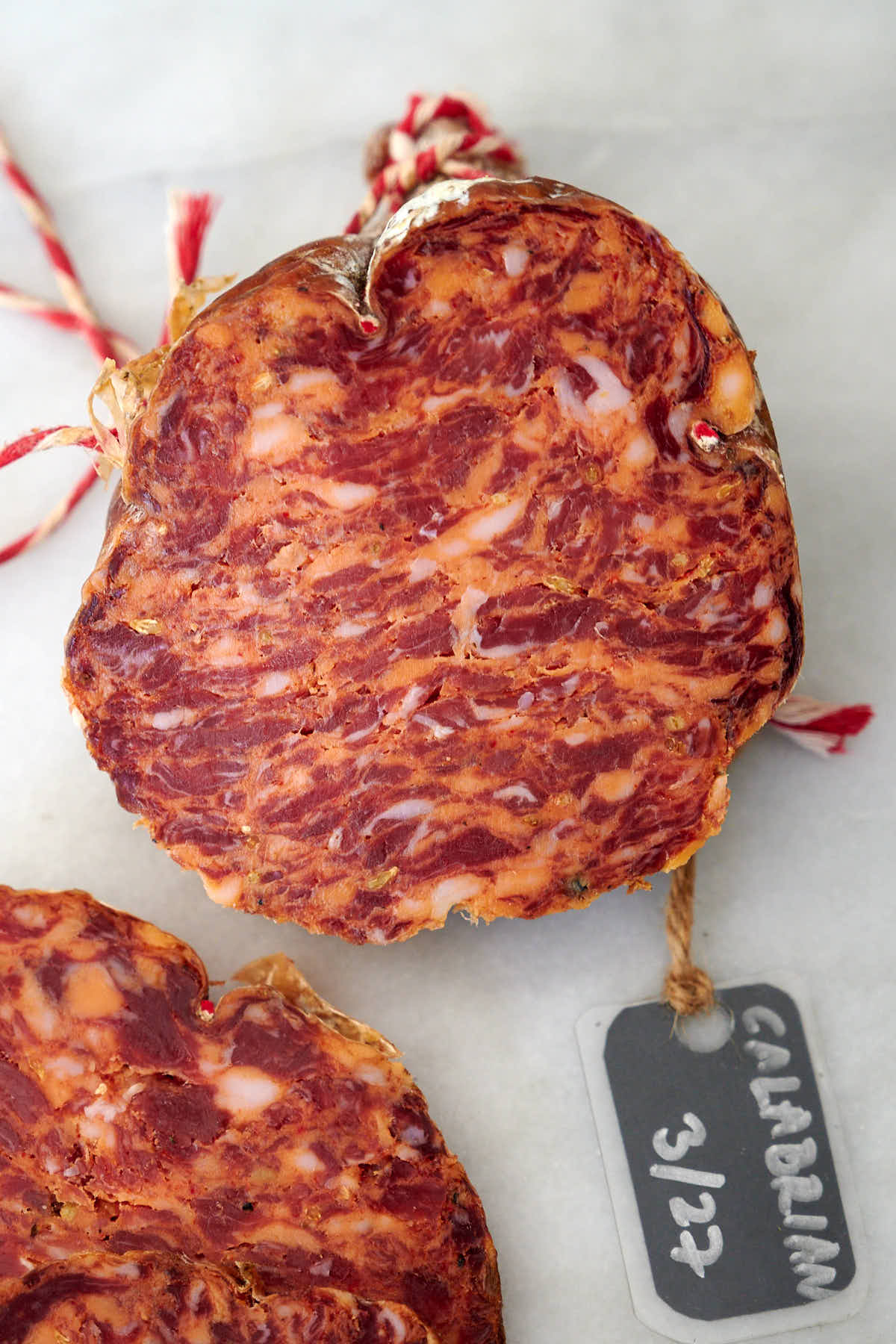
I've tried quite a few examples of this fine salami, some were mild, and some were so hot that I could barely eat them. I learned that my type of Calabrese salami was neither mild nor very spicy, but somewhere in between. To make a long story short, here is my favorite Calabrese salami recipe that I've been using for years. The sausage is moderately spicy with great flavors and a nice after taste. I make it every year.
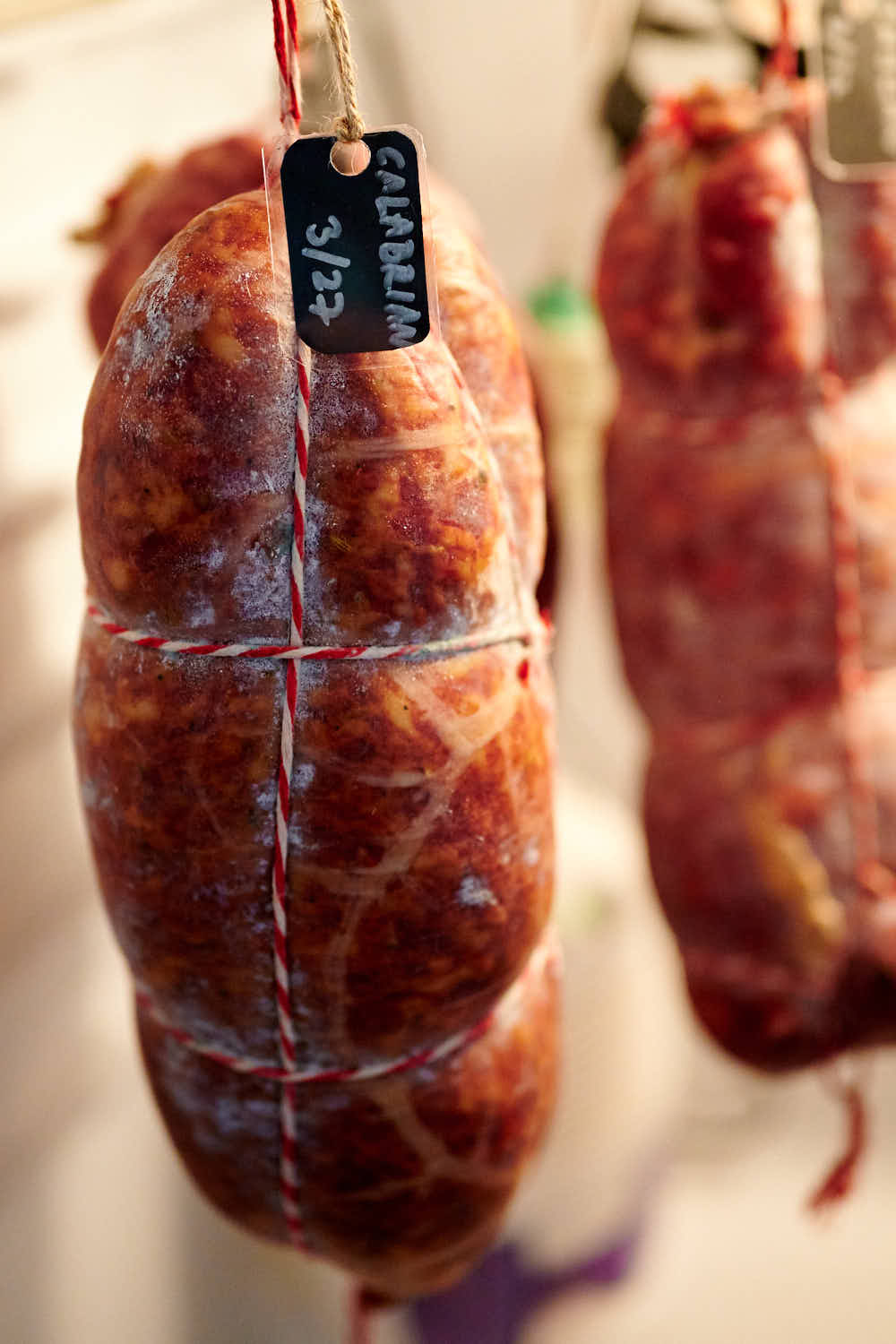
Making Calabrese salami
The meat
The optimal ratio of lean pork to fat is 75/25. You can go a little lower or a little higher, but don't go less than 23% and more than 30% fat. Lean meat may come from any pork cut: shoulder, ham, neck, or loin. Back fat is ideal for making salami. It's firm and prone to smearing. If you can't find it, and often it's not easy to find, use pork belly.
Meat quality makes a big difference, so pick the freshest and the best meat you can find. Pasture-raised heritage pork is ideal. This is the first time I am making Calabrese salami with Berkshire pork. My cured bacon made with this pork was exceptionally good. I expect this salami to be nothing less, but we'll see. Check out your local farms, you may be able to get very good deals if you place a large enough order.
I grind the lean meat through a 1/4-inch (12 mm) grinder plate, and the back fat through a 1/4-inch (6mm) grinder plate. A good, powerful enough meat grinder with sharp knives is key for making salami. A powerful meat grinder with sharp knives means good meat and fat definition which will promote efficient drying, better texture and better enjoyment of the final product. I've been using a LEM Products Big Byte #8 for years and highly recommend it. It's portable enough to easily carry around but powerful enough to get the job done well.
Seasonings and spices
For seasonings, I use salt, pepper, fennel and sweet and hot Calabrian paprika. To get that authentic Calabrian taste, you must use the real Calabrian paprika imported from Calabria which you can buy on Amazon. Other places that carry it are Sausage Debauchery and Italian Harvest. All these places seem to only carry the hot variety so if you can't find the mild pepper, just use fresh (as in not old/stale) Spanish or Hungarian paprika.
If you live near large Italian communities, try local grocery stores that cater to them, they will most likely carry those as well.
For weighing the seasonings, I recommend using a precision scale, like this Precision Pocket Weight Scale. The amounts are small, so using a scale in grams makes things very easy. Calculating the amounts in grams when scaling the recipe also makes it a lot easier.
Stuffing
You can stuff the meat in various size natural casings, from 32mm to 110mm. Thinner salami will be ready after 4-8 weeks, while thicker may take 3+ months to mature. I prefer thicker casings for this type of salami.
Drying and maturing
In the past, I would stuff my salami and dry-cure at the standard 55F and 75% RH until 35% weight loss. This is a good approach, so use it if you are more comfortable with it and have had good results with it.
Lately, I've been using a new process that I like a lot and which I wrote about in homemade capicola and pancetta posts. I've had much more consistent drying with it, low risk of case hardening and an improved flavor. It starts with what they call in Italy 'dripping' and goes into intensive drying over the following 6 days. Salami lose a lot of water during the first week, so the modified temperature/humidity schedule ensures that water removal is optimal during this time and the casing stays hydrated to prevent hardening.
For thicker salami (75mm - 110mm), I use the following schedule:
| Stage | Duration | Temp | RH |
|---|---|---|---|
| Dripping | 14 hours | 77F (25C) | < 99 % |
| Drying | 17 hours | 73F (23C) | 75-85 % |
| Drying | 24 hours | 71F (22C) | 68-78 % |
| Drying | 24 hours | 68F (20C) | 65-75 % |
| Drying | 24 hours | 64F (18C) | 68-78 % |
| Drying | 24 hours | 61F (16C) | 72-82 % |
| Drying | 24 hours | 59F (15C) | 76-86 % |
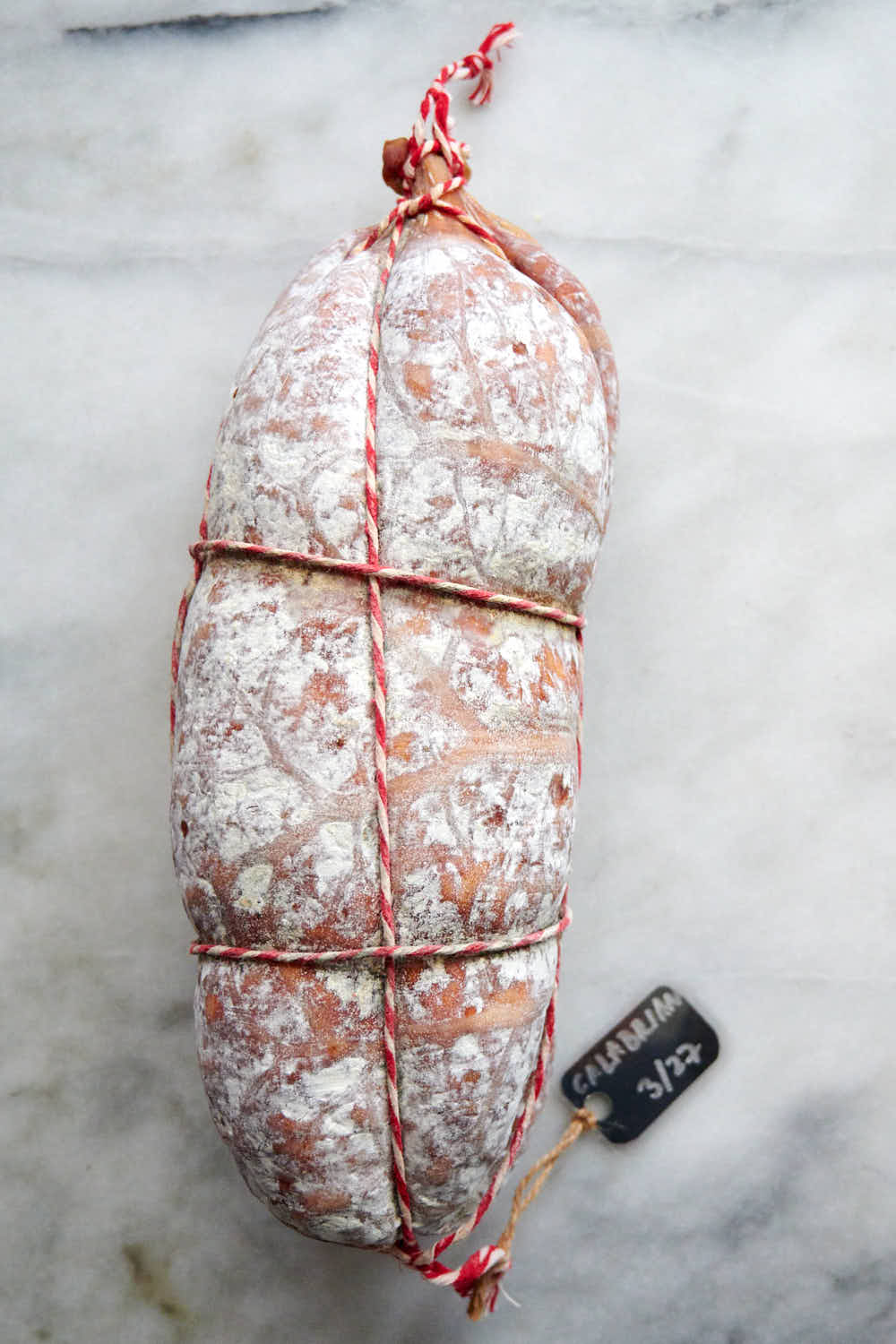 Smoking
Smoking
It's not uncommon to find Calabrese salami to have a smoky flavor. Calabrians use natural wood smoking for 3 days and a maximum of one week.
Salami weight loss progress
Below is the weight loss progress of my 110mm Calabrese salami.
| Weight, g | Loss, g | Loss, % | |
|---|---|---|---|
| Start | 2,512 | ||
| 3 days | 2,356 | 156 | 6.2 % |
| 5 days | 2,286 | 226 | 8.9 % |
| 7 days (end of drying) | 2,244 | 268 | 10.6 % |
| 12 days | 2,155 | 357 | 14.2 % |
| 23 days | 2,022 | 490 | 19.5% |
| 1 Month | 1,975 | 537 | 21.4% |
| 2 Months | 1,799 | 713 | 28.4 % |
| 3 Months | 1,694 | 818 | 32.6 % |
| 4 Months | 1,653 | 859 | 34.2 % |
Maturing
After drying, the salami went into the meat curing chamber where it will slowly mature at 55F - 57F (13C - 14C) and 80% - 84% for 3+ months.
Starting, interim and target pH
The starting pH was at 5.79, which dropped to about 5.10 by the end of the 7th day.
I expect the pH to continue dropping a little lower over the following 3 days, level off and gradually come back up a little.
Tasting notes
This recipe is one of the most popular salami recipes at our home. Perhaps even the most popular. It's easy to determine that by how quickly the salami disappears. This one usually goes the quickest.
It's very visually appealing and the flavors are rich and robust. There is a noticeable sweetness from the paprika coupled with mild to moderate, depending on who you ask, spiciness. I make this salami so you can feel the heat but it's not offputting and even those who don't like spicy food quite enjoy this sausage.
Sweet, savory, porky and spicy just enough. A definite crowd-pleaser. Fennel aroma comes through quite nicely. I love the savory taste of the paprika, it makes this salami quite addictive. A couple of slices of this salami on a freshly baked baguette or a croissant, or a slice of white bread, and I am in heaven.
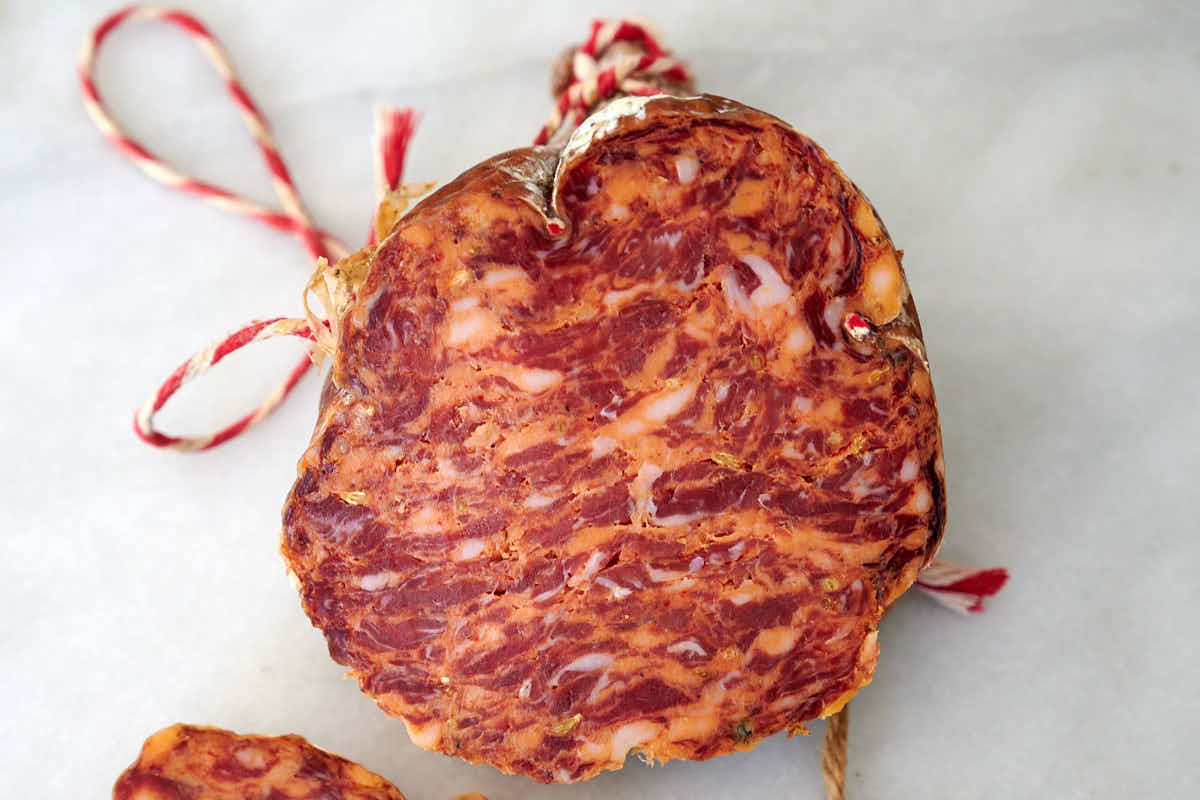
In this particular batch, the pH finished at 5.29, giving the salami a nice tang that plays well with the sweetness of the paprika.
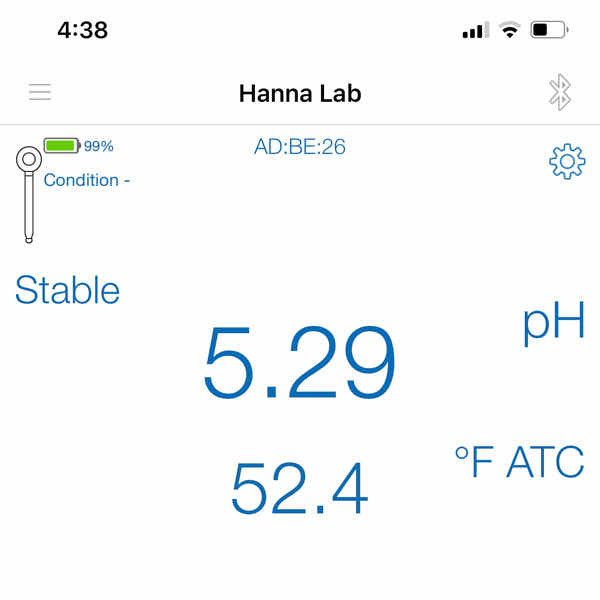
I have no good explanation as to why, for example, my Bergamo salami that was fermented and matured together with the Calabrese finished at 5.47. It's possible that the grind and the spices play a role in that. That said, I enjoy seeing these variances and unexpected (positive) results. That's how you learn, experience new things/tastes and come up with new ideas.
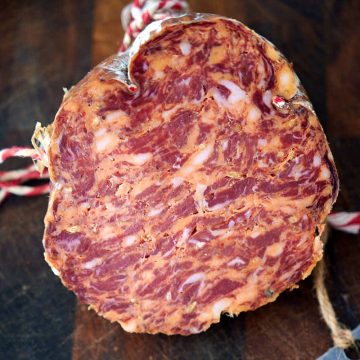
Ingredients
- 750 g lean pork ham, shoulder, neck (coppa), or loin
- 250 g back fat
- 25.5 g sea salt
- 2.5 g Cure #2
- 2 g dextrose
- 0.12 g T-SPX culture
- 60 ml distilled water see note
- 4.5 g Calabrian spicy chili pepper powder or up to 10 g per kilo for a spicier taste; use cayenne pepper as a 1:1 substitute if needed
- 8 g Calabrian sweet chili pepper powder or up to 15 g per kilo if you like; Spanish or Hungarian sweet paprika are good substitutes
- 4 g fennel or as high as 10 g per kilo
- 1.5 g black pepper ground
- 1.5 g black pepper whole
Instructions
- Rehydrate the starter culture in 60 ml distilled water. (see notes)
- Weigh the lean meat and the back fat in grams. Divide the total weight by 1000, then multiply each ingredient by that number, except the distilled water (see notes). For example, if the combined weight of the meat and back fat is 2650 g, you need to multiply the ingredients specified above by 2.65.
- In a small bowl, combine the salt, Cure #2 and dextrose.
- Cut the meat and the back fat into 1-inch pieces, and place into separate bowls. Sprinkle 3/4 of the salt mixture over the lean meat and the remaining 1/4 over the back fat. Mix each well to ensure even distribution. Freeze both for 20-30 minutes.
- Grind the lean pork through a 1/2-inch (12 mm) grinder plate. Grind the back fat through a 1/4-inch (6mm) grinder plate.
- Combine the lean pork with the starter culture and all of the seasonings. Mix well, until sticky, then mix in the groud back fat. It helps to use a stand mixer with a paddle attachment for this.
- Stuff into beef bungs and tie into 10-inch (25cm) links.
- Using a sterilized needle or sausage pricker, prick holes across the entire salami.
- Weigh the salami, write down its weight on a tag and attach the tag to the salami.
- If desired, inoculate with mold.
- Use the leftover meat from the stuffer/stuffing tube to make a small sample for measuring the initial pH and the pH at later stages. Make sure to record the readings.
- Dry at 59F - 77F (15C - 25C) and 65%-86% RH for a period of 7 days as per the drying protocol above. Measure the pH, it should be below 5.3 at this point.
- Mature in the curing chamber at 55F - 57F (13C - 14C) and 80% - 84% for about 3+ months.
Alternative curing method
- Ferment salami at 68F-70F for three days to get the pH below 5.3.
- Cure at the standard 55F-57F and 75% RH until 35% weight loss is obtained.


simon wraight says
Hi,
I've been experimenting with paprika paste for this recipe. The penny just dropped that there is sugar in the paste, causing my PH to dip to 5.0, lower than required and probably introducing some sour notes.
Thought I'd share for others to benefit.
Sinan Sabuncuoglu says
I enjoyed your very detailed explanation of the process. It looks as almost impossible for me to make justice to it by being able to follow the instructions precisely as it was noted. I do wonder however, if you would make your CALABRESE salami available for public consumption. We enjoy good Calabrese Salami at home very much.
Thank you - Sinan
Victor @ Taste of Artisan says
Hi Sinan, it's not that hard once you start and do a couple of batches. The more you make it, the easier and more intuitive it gets, and the results get better and better
Unfortunately, I don't sell my cured products as I am not licensed for that, nor do I want to turn this hobby of mine into a business. Maybe in the future I somehow will, who knows...
Heywood says
Hi Victor.
So tomorrow I am going to give your recipe a go. Don't have calabrian chili, but some pretty seedless pepper flakes that I am going to grind and probably hungarian paprika because the spanish pimenton I also have, I find too identifiable/marked in terms of taste.
So I have a question if you don't mind.
I have both beef bungs 55/60mm and 40/44mm hog casings. Which one would you use ? Half and half ?
Other question : what's your opinion on frozen back fat ? That's all I could get my hands for this endeavour.
Thanks in advance for your advice.
Victor @ Taste of Artisan says
Hi Heywood, good stuff. This salami is great. Well, any traditionally made salami is great... can't find it in stores here, too expensive for them to make.
Sure, you can do half and half... Just remember, the thicker they are, the trickier it is to dry them evenly. Also, it will take longer for the thicker ones.
In every batch I do a combination of thicker and thinner, as thin as 21mm, to have something ready sooner.
Frozen back fat is perfectly good as long as it was stored properly - vac sealed, non-frost free freezer, etc. I use it all the time. I often buy hlaf a hog, butcher it myself and and save back fat for future use. I've used one as old as two years and it was perfectly fresh.
Good luck.
Heywood says
Thanks for the answer Victor.
So being the stingy person that I am I decided to go for the beef bungs only because it meant I wouldn't have to open my pack of hogs which has a best before date in more than a year.
Wow I think I will never forget opening that first pack of bungs, that smell is brutal.
Plus being kind of a noob at using my stuffer I figured it would be way easier dealing with only one type of casing.
So now they kind of look like the ones in your first picture. Really reminds of typical french smoked sausage "of Morteau" at this point.
I gave them 3 days of fermentation using Flavor of Italy (trying to stick more or less to your calendar, but I decided to give just three days sincee you mentionned it applied to pretty large casings)
They ended up in the chamber with a reading of 5.23, which seems ok depending on the accuracy of my chinese phmeter.
Very good to know about back fat thats what I did with my left over.
Tasting bangers for the first time yesterday I made without backfat but just belly, i realised how important it is to making charcuterie. They tasted ok but more like stuffed meat that proper sausages. As we say in french : "le gras c'est la vie"
Cheers
Victor @ Taste of Artisan says
Hi Heywood, yeah, I hear you. They can have a pretty strong smell but I also noticed that the smell varies from place to place. Some do a much better job cleaning them and they certainly don't smell nearly as bad as some other ones that I'd tried. Casings usually store pretty well for me for a very long time in a fridge. The ones that I get here aren't sealed either. Add enough salt and they will store a long time. Some come in some kind of liquid and threaded on a stick, these are usually sheep and hog casings, I re-pack them after opening and they seem to store well and and for a while too.
5.23 is good. It will continue dropping for about 12-12 days and eventually come back up during maturing. That's the beauty of traditionally made Italian salami, it has very mild and pleasant acidity, unlike most commercially made salami these days.
Fat, that's life? LOL it certainly is. Can't get around it and there is nothing wrong with some natural fat in moderate quantities.
Good luck with your charcuterie adventures. It's such a rewarding hobby.
Simon says
Hi,
I just made these as my first attempt at curing. I soaked the middles but did not wash them. They are very smelly things 🙂
Have I ruined the salamis or will the smell eventually go away?
Thanks for inspiring me to curing!
Victor @ Taste of Artisan says
Simon, some of them can be quite smelly. I've noticed that if they clean and handle them well from the start, some places are very good at that, they won't smell much at all. At other places they don't clean them well enough and the smell can be quite noticeable. The good thing is that the smell doesn't seem to permeate the meat and you won't notice it after the salami is done curing. At least I never did. If you do detect some unpleasant smell after removing the casing, wash the sausage with red wine, then air dry before slicing. That should help. In the future, if the casings have a smell, soak them in clean cold water with lime and lemon wedges overnight. Squeeze some juice into the water. Keep refrigerated. The next day wash/rinse as usual. I triple rinse before using. Good luck!
simon says
Ah thanks for the reply Victor, very helpful!
Victor @ Taste of Artisan says
You are very welcome, Simon. Be sure to try my sujuk, my family, especially the kids, loves it. I recently made a second batch this winter as my kids kept askig for it. The aroma when it's fermenting is the best I've ever smelled. Delicious!
https://tasteofartisan.com/wp-content/uploads/2024/02/sujuk.jpg
Joe says
Many in Calabria use dried peperoncino in polvere but if you want to do la vera sasizza Calabrese and you can get your hands on it, may I suggest you try the key traditional ingredient. Use sweet pepper sauce instead of dry powder. It's difficult to find in some smaller areas but not too difficult to make if you don't have access. In addition to the flavour it keeps the texture just right.
Victor @ Taste of Artisan says
Thanks for the tip, Joe, I will try those. I've heard about the pepper paste/sauce but never tried it myself.
Daniel says
I recently purchased some Calabrese salami at my local Whole Foods market. The first slive into the salami I was having to strain to cut through. Is all Calabrese so hard? If so, why is it so hard? I’ve tried various salamis, from the soft, to the hard and dry, to the hardest I’ve found. But none were as hard as that Calabrese.
Victor @ Taste of Artisan says
Daniel, in one of my Italian salami resources Calabrian Salame/Soppressata is described as - translated - compact texture tending to be soft. Mine come out firm but also on the softer side. Why the one you tried was so hard? It could be a combination of things - coarseness of the grind, fat content and how it was cut, how it was mixed, how long it was dried... e.g. leaner sausage dries faster and harder. If the sausage has been handing in the curing chamber at lower humidity, eventually it will dry out and become hard, so it helps to bump up humidity once you've reached the target weight loss but still want to continue maturing it to develop richer flavor.
Joe says
It's semi-firm but should not be difficult to cut through. Respectfully.... Whole Foods is not the place to get sasizza Calabrese. I'm sure where you're located but if you're going to buy it you will need to find a shop with some history. The smaller the maker the better. Try and find an artisanal product
Victor @ Taste of Artisan says
Even those can be hit or miss. I remember buying some soppressata and salame from a local artisanal charcuterie place and I did not find their sausage particularly good. Their soppressata made of Berkshire pork was super expensive, which I naively equated to very good, turned out to be stale, probably had been sitting on the counter for a long time. I've had the best luck buying truly good specimens (imported from Italy) from the local grocery store that caters to the local Italian community.
Joe says
Respectfully..... Sasizza, is not "charcuterie" (french)... It's "salumi" (italian)
Victor @ Taste of Artisan says
Joe, I am aware of that;)...sasizza,salsiccia.... actually influenced by French saucisse... all have the same Latin root anyway... No, I meant to say charcuterie... Rightly or wrongly, I tend to call those shops Charcuterie, Salumi or Norcineria shops interchangeably. I make French dry cured sausages too you know... and German, Balkan, Spanish, Russian, Polish... LOL
Rob H says
Is it possible to use Calibrian Peppers (canned) and perhaps blended in lieu of dry?
Victor @ Taste of Artisan says
Rob, my apologies for the late responses. I've never tried but I know it's possible. Someone used fresh peppers to make salami and he was quite happy with the results, there is even a picture of it somewhere here on the blog in the comments. It looked good.
Rob says
Do you have any recommendations on how to keep your grinder knives sharp? I know Sausage Maker sells a meat grinder knife sharpening kit, but my grinder isn't a standard size like #8 or #12 so I'm not sure it will work. I've also seen some Youtube videos where knives and plates are sharpened using different grades of emery paper. I was curious what you do. Thanks.
Victor @ Taste of Artisan says
Had no idea that product existed, looks cool, I will give it a try. That said, I've been sharpening my grinder knives and plates with sandpaper of various grit on a flat surface. Tiresome, tedious and boring.
Daniel says
Hi Dear Sir. You are kindly requested to post a good recipe for fresh sausage of pork meat the hot and spicy and the mild flavoured I am asking these recipes because I consider you Sir my honourable professor in sausage processing thanks and best regards
Victor @ Taste of Artisan says
Hey Daniel, I am honored, thank you for the kind words. Have you tried my Italian sausage yet? It's a very good. You can find it in fresh sausage recipes on my blog. There are other favorite ones of my there. I will for sure be posting more in the near future. By the way, you can turn this calabrese salami into fresh sausage, I've done that too, it's delicious. I use 6 grams of salt per lb od meat and of course you don't need the starter culture and sugar. A little bit of sugar is not a bad thing though.
Daniel Djerdjerian says
Dear Victor Hi please allow me to leave this comment so in the working instruction you mentioned on the number 5 to chop the lean pork through 1/4 inch plate and in between brackets 12 mm and the same for the back fat 1/4 inch 6 mm there is a slight mistake 12mm Equals 1/2 an inch so please you advise me to chop the back fat with the 12 mm plate and the lean meat with the. 6 mm or the contrary thanks and best regards awaiting your kind reply
Victor @ Taste of Artisan says
Hi Daniel,
thanks for pointing out the typo, I corrected it. I use 1/2" (12mm) for lean and 1/4" (6mm) for fat/fatty pork. You don't want fat in large chunks though some people like it. My family likes smaller fat pieces so I often go lower, like 3/16″ (4.5mm). The grind that my kids and my wife like a lot is 3/16″ (4.5mm) for both lean and fatty pork - please see my Finocchiona recipe. There is really no right or wrong here, it's all about how you personally like it. That's the beauty of curing salami at home as you can make it exactly how you like it.
Daniel says
Thank you dear Sir for replying to my question Best regards
William says
Thanks for sharing - your information is great and it is laid out superbly with nice pictures - it is obvious a lot of work
Victor @ Taste of Artisan says
You are welcome.
Mark makovec says
Beautiful site and salami.. Which type and where do you get the beef bungs. Sausage maker has textile cap end beef bung casings. You would soak for a few minutes in salt water.
Thank you for the help.
Mark
Victor @ Taste of Artisan says
Thank you, Mark. I mostly use natural casings. I'd say 95% of the time I use natural. Back in the day I experimented with both natural and synthetic and have always liked natural more. I get beef bungs from various places, the sausagemaker sells natural ones, from a local grocery store that caters to the Italian community, they sell all sorts of casings including salted veils that I love using for large muscles. There is also a local supplier that caters to sausage making businesses but they sell to retail customers too. They have a lot of items in stock but can order for you if they don't.
Jaye says
Hi there: I have a bumper crop of Calabrese hot peppers in the garden. I want to make some salami but I've only ever used dried peppers. Can I use the fresh peppers do you think, or should I dry them first?
Victor @ Taste of Artisan says
To be honest, I've never made or heard of anyone making salami with fresh peppers. I've only gone as far as using a small amount of fresh garlic. I don't know how it will affect the curing of the meat and whether it will spoil rather than dry cure along with the meat. I've had some tell me they used roasted peppers to make sopressata though. Personally, I would dry them first.
Joe says
Traditionally, it's not done with fresh peppers (although you could) simply because salumi is traditionally made in the dead of winter when fresh peperoncini are non-existant.
Victor @ Taste of Artisan says
LOL At first I didn't understant your comment, Joe, but after reading it again and quickly going through my post, I now get it. No, I did not mean 'fresh' fresh. I meant fresh as opposed to not old/stale. So many people tend to buy some regional spices and keep them for years as they don't use them a lot. I was guilty of that myself back in the day. Now I try to use the freshest ingredients I can. I am even thinking of growing my own peperoncini peppers. A colleague of mine makes his own pepper paste from home-grown peppers and uses it to make Calabrese. I'd like to try that.